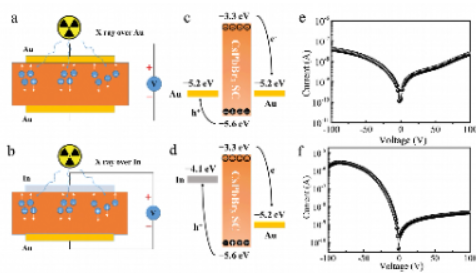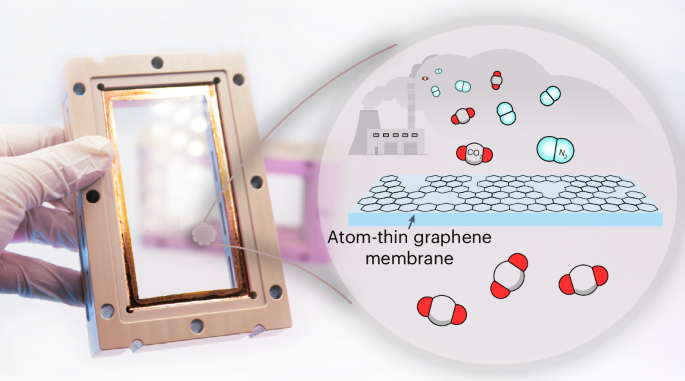2025-04-08 中国科学院(CAS)

<関連情報>
- https://english.cas.cn/newsroom/research_news/phys/202504/t20250410_1040897.shtml
- https://advanced.onlinelibrary.wiley.com/doi/10.1002/adfm.202500039
- https://pubs.aip.org/aip/apl/article-abstract/125/8/083507/3309285/Freezing-non-radiative-recombination-in-high?redirectedFrom=fulltext
X線検出器用CsPbBr3ウェハのイオンマイグレーションを抑制する2-ブロモナフタレン誘起欠陥パッシベーションの開発 2-Bromonaphthalene-Induced Defect Passivation to Suppress Ion Migration in CsPbBr3 Wafer for X-Ray Detector with Bias-Resistant Stability
Xiao Zhao, Ziqing Li, Shimao Wang, Yanan Song, Enliu Hong, Tingting Yan, Gang Meng, Xiaosheng Fang
Advanced Functional Materials Published: 17 March 2025
https://doi.org/10.1002/adfm.202500039
Abstract
Featuring exceptional photoelectronic properties and scalability, hot-pressing processed all-inorganic (i. e., CsPbBr3) perovskite wafers have emerged as promising candidates for direct X-ray imaging. Nonetheless, severe ion migration in CsPbBr3 wafers results in a large and drifting dark current, thereby compromising the bias-resistant stability of the X-ray detector. Herein, a solvent-free interfacial defect passivation strategy is proposed by introducing a passivator molecule, 2-bromonaphthalene, to passivate interfacial defects and suppress ion migration in CsPbBr3 wafers. Implementing this strategy effectively inhibits ion migration in CsPbBr3 wafers, as evidenced by an enhanced ion migration activation energy of 0.56 eV and a negligible dark-current drift of 4.01 × 10−8 µA cm−1 s−1 V−1, representing a 100 fold reduction in dark current drift compared to untreated CsPbBr3 wafers under a high electric field of 100 V mm−1, indicating a high bias-resistant stability. Consequently, the CsPbBr3 wafer X-ray detector achieves an impressively high sensitivity of 11090 µC Gyair−1 cm−2, a low detection limit of 9.41 nGyair s−1 under a 100 V mm−1 electric field, and high-contrast X-ray imaging capabilities, with performance comparable to that of CsPbBr3 single-crystal-based X-ray detector, highlighting the potential of interfacial defect passivation strategy for high-performance X-ray detectors.
高性能CsPbBr3単結晶X線検出器における非放射再結合の氷結化 Freezing non-radiative recombination in high-performance CsPbBr3 single crystal x-ray detector
Xiao Zhao;Shimao Wang;Yanan Song;Toru Aoki;Volodymyr Gnatyuk;Libing You;Zanhong Deng;Ruhua Tao;Xiaodong Fang;Gang Meng
Applied Physics Letters Published:August 21 2024
DOI:https://doi.org/10.1063/5.0224223

Though CsPbBr3 single crystals (SCs) possess intriguing photoelectronic properties for x/γ-ray detection, the serious ion migration and high thermally activated carrier concentration at room temperature (RT), typically associated with defect states in CsPbBr3 crystals, result in a high dark current and drift of baseline, hindering their potential applications. In this investigation, liquid nitrogen cooling is proposed to freeze deep-level defects in CsPbBr3 SCs, thereby suppressing the ion migrations and decreasing the thermally excited carrier concentration. Utilizing photoluminescence (PL) and time-resolved PL spectra, coupled with theoretical models for photoexcitation and photoemission processes, the freezing of deep-level defects at liquid nitrogen temperature (LNT) is confirmed, which is conducive to decreasing non-radiative recombination. At LNT, the CsPbBr3 SC exhibits a higher resistivity of 4.95 × 1011 Ω cm and a higher mobility–lifetime product of 9.54 × 10−3 cm2 V−1, in contrast to the RT values of 3.86 × 109 Ω cm and 3.67 × 10−3 cm2 V−1, respectively. Furthermore, the x-ray detector at LNT exhibits a high sensitivity of 9309 μC Gyair−1 cm−2 and an impressively low detection limit of 0.054 nGy s−1, which offers a route for obtaining highly sensitive x-ray detectors for applications including ultra-low dose radiation imaging.



